SDA (Space Development Agency)
Tools and Platforms
SDA (Space Development Agency) to Create a Marketplace for Commercial Satellite Data
The Space Development Agency is looking to work with commercial operators of imaging satellites so they can send data directly to U.S. government satellites in orbit, the agency’s director Derek Tournear said 22 June 2021. 1)
The idea is to make it easier for Earth observation satellite operators to sell their data to the government without having to download it to ground stations, Tournear said at the Defense One Tech Summit.
Using optical inter-satellite links, companies could send data directly from their constellations to SDA’s satellites, he said.

SDA is building a network of data-relay satellites in low Earth orbit known as the Transport Layer. It plans to have as many as 150 satellites in orbit by 2024 and hundreds more could follow. Each satellite in the network would have multiple optical communications terminals to pass data to other satellites and to military platforms like aircraft, ships and command centers on the ground.
To detect and track missiles that could be aimed at U.S. forces, the SDA is building a network of surveillance sensor satellites known as the Tracking Layer. The agency also plans to use commercial satellite imagery to help track these targets.
“SDA wants to create a market,” Tournear said.
Optical inter-satellite links “open up a completely new way to move data,” he said.
The agency is interested in working with operators of electro-optical, radar imaging or other types of observation satellites. “We would say, ‘hey, can you put an optical crosslink on your satellite so that it can talk directly to our Transport Layer so that then we can fuse the data and get it directly to the warfighter,’” Tournear said.
This would give the industry “another channel to market,” he said. “They don’t have to download the data and put it out on the market and then sell it back to the government. They can essentially sell it to the government as they as send it to our Transport Layer.”
Tournear said a draft request for proposals for the next batch of Transport Layer satellites will be issued in the coming weeks. A final request for proposals is expected in August.
• July 26, 2021: Launch services for Space Development Agency satellites will be procured under the National Security Space Launch program run by the U.S. Space Force, according to an agency announcement. 2)
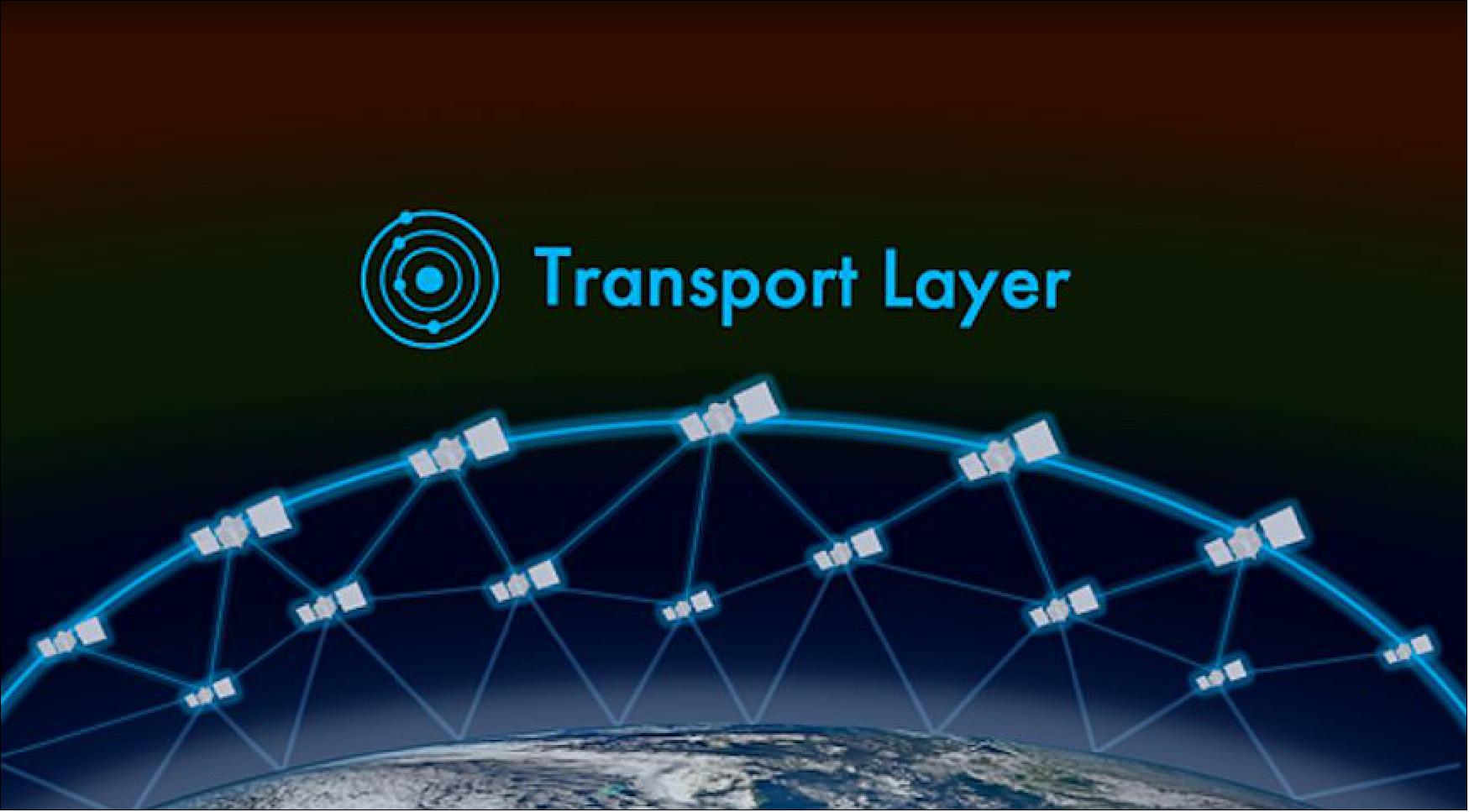
- SDA will be seeking bids later this year for up to 150 satellites for the Transport Layer Tranche 1 projected to start launching in late 2024.
- SDA is a Defense Department agency that is building a large constellation of small communications satellites in low Earth orbit known as the Transport Layer. The agency previously awarded SpaceX a $150.4 million contract to launch its first 28 satellites in 2022 and 2023. But future launches will be procured from either ULA (United Launch Alliance) or SpaceX under the National Security Space Launch program (NSSL).
- The next batch of satellites to be launched by SDA will be much larger than 28. The agency will be seeking bids later this year for up to 150 satellites for the Transport Layer Tranche 1 projected to start launching in late 2024.
- ULA and SpaceX were selected last year as the NSSL Phase 2 launch providers from 2022 until 2027. Each company is assigned specific missions on a yearly basis over the five year period.
- Most of the payloads launched under the NSSL program are large military and intelligence agency satellites. SDA would be the first NSSL customer building such a large constellations of small satellites in low Earth orbit.
- For the Transport Layer Tranche 1, SDA initially planned on allowing the satellite prime contractors to procure the launch services under commercial contracts. On July 26, the agency announced that launch services procurement will be handled by the Space Force’s NSSL program.
- “SDA now intends to procure launch services through the USSF NSSL Phase 2 contract. Accordingly, it is anticipated that the contractor procured launch services language will be removed from the final RFP [request for proposals],” SDA said.
Transport 3)
- SDA’s Transport Layer will provide assured, resilient, low-latency military data and connectivity worldwide to the full range of warfighter platforms.
- SDA’s Transport Layer is envisioned, modeled, and architected as a constellation varying in size from 300 to more than 500 satellites in Low Earth Orbit (LEO) ranging from 750 km to 1200 km in altitude. With a full constellation, 95% of the locations on the Earth will have at least two satellites in view at any given time while 99% of the locations on the Earth will have at least one satellite in view. This will ensure constant world-wide coverage around the globe. The constellation will be interconnected with Optical Inter-Satellite Links (OISLs) which have significantly increased performance over existing radio frequency crosslinks. LEO orbits in conjunction with OISLs will reduce path loss issues but more importantly offer much lower latencies, which are deemed critical to prosecute time sensitive targets in today’s wartime environment.
- This SDA constellation is expected to operate over Ka band, have stereo coverage and be dynamically networked for simpler hand-offs, greater bandwidth and fault tolerance. Initially, the Tranche 0 constellation consisting of 20 space vehicles is expected to have a limited networked capability. Future enhancements (Tranche 1 and beyond) will significantly increase the routing of data across a larger network of space vehicles. The constellation will also have the capability to integrate with both Link-16 and the Integrated Broadcast System (IBS). Link-16 and IBS integration on the Transport Layer will modernize current capabilities to better support warfighter needs for worldwide timely threat warning and situational awareness information across the range of military operations.
SDA’s Transport Layer is exploring technical areas including, but not limited to:
- Optimized control of modulation techniques (including wide-band or narrow-band operations),
- Simultaneous transmit and receive technologies,
- Communications security functions (e.g. frequency hopping),
- Unique state of the art waveforms,
- Space implementation of tactical data links,
- Automated dynamic networking and routing techniques,
- Commercial cryptographic systems,
- Blockchain technologies,
- Multiband phased array antennas, and
- Multi-level security (MLS).
Development Status
• July 18, 2022: The Space Development Agency (SDA) announced July 18 it selected L3Harris Technologies and Northrop Grumman to each build 14 missile-tracking satellites for a low Earth orbit constellation known as the Tracking Layer. 4)
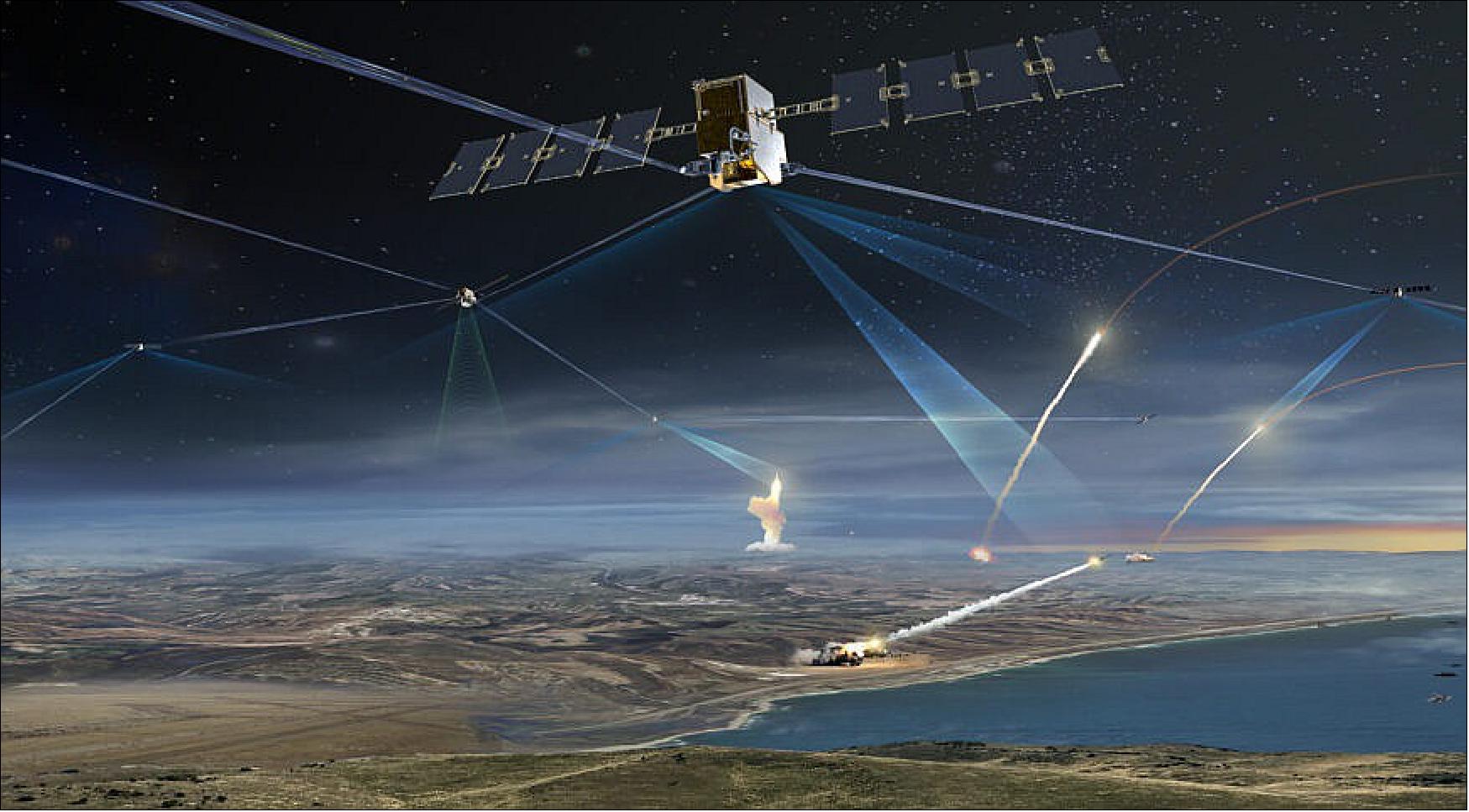
- L3Harris won a $700 million contract and Northrop Grumman a $617 million deal for the Space Development Agency’s Tracking Layer Tranche 1.
- The 28 infrared-sensing satellites will be part of a global network of eyes in the sky intended to detect and track the latest generation of ballistic and hypersonic missiles being developed by some countries.
- Speaking at a Pentagon news conference, Space Development Agency Director Derek Tournear said the 28 spacecraft will be launched in batches of seven to polar orbits about 600 miles above Earth. Each plane of seven satellites will be deployed over different locations around the globe. The first launch is projected in April 2025.
- Having a constellation of infrared sensing satellites in low Earth orbit has emerged as a top priority for the Pentagon amid concerns that current defense systems might not be able to detect low-flying hypersonic missiles.
- SDA’s Tracking Layer satellites should be able to see targets with greater fidelity than current DoD missile-defense satellites in geostationary orbit 22,000 miles above the equator. Existing satellites provide global missile warning and detect launches of short-range and intercontinental ballistic missiles, but they were not designed to track advanced maneuvering missiles like hypersonic glide vehicles.
- SDA in 2020 ordered the first eight satellites of the Tracking Layer — known as Tranche 0 — from L3Harris and SpaceX. The first two Tranche 0 satellites are projected to launch in 2023.
- SDA estimated the entire cost of the Tracking Layer Tranche 1 will be about $2.5 billion, a price tag that includes the 28 satellites as well as four launches, ground integration and support costs.
- Tournear said seven proposals were received for Tracking Layer Tranche 1. The two winning bids were selected based on their schedules, technical merit and price.
- Both L3Harris and Northrop Grumman won so-called “other transaction agreements” used by the Pentagon as alternatives to traditional contracts. These agreements require contractors to team with nontraditional commercial vendors. Neither L3Harris nor Northrop has yet disclosed its commercial partners for this contract.
- These are the second major contracts that L3Harris and Northrop Grumman have won to date from DoD’s space agency. L3Harris got a contract for four Tracking Layer Tranche 0 satellites and Northrop Grumman won a 42-satellite deal for SDA’s broadband constellation called Transport Layer Tranche 1.
- The data collected by Tracking Layer satellites would be sent via optical links to the Transport Layer so if a missile threat is detected, its location and trajectory data can be transmitted securely through space and downlinked to military command centers.
- Both the Tracking and Transport Layers will be built in increments over several years, with new satellites acquired every two years. The next Tranche 2 of the Tracking Layer is expected to have 54 satellites.
- “The T1 Tracking Layer effort is a critical step toward building the national defense space architecture,” Tournear said. “SDA is confident that selection of the L3 Harris and Northrop Grumman teams provides the best overall solution to accelerate delivery of a low-Earth orbit constellation with wide-field-of-view infrared sensors for a global missile warning and missile tracking capability.”
• July 5, 2022: Northrop Grumman announced July 5, it selected Airbus as its satellite bus supplier for the U.S. Space Development Agency’s low Earth orbit constellation. 5)
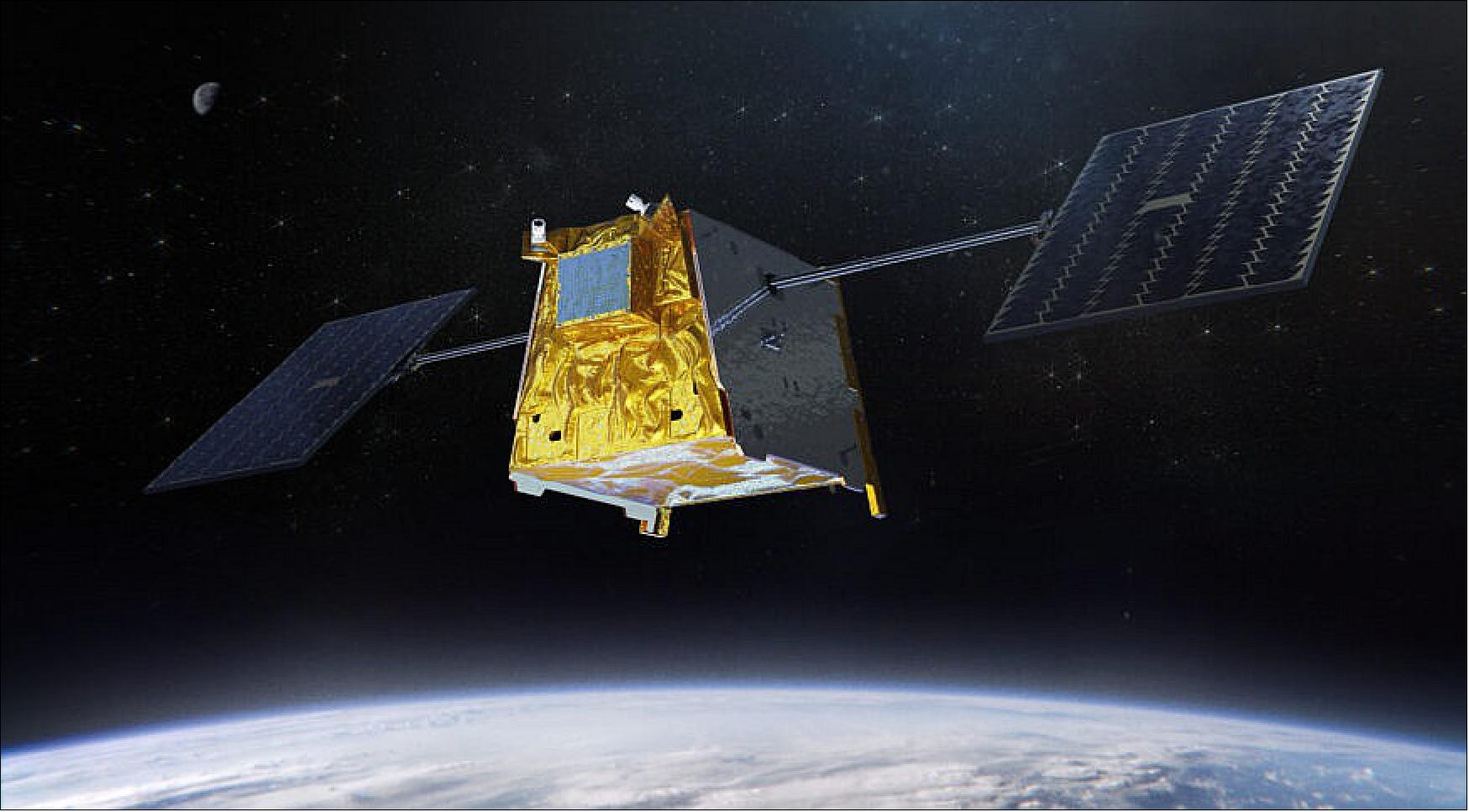
- Northrop Grumman in February won a $692 million contract from SDA, one of three companies selected by the Pentagon’s space agency to each produce 42 satellites projected to launch in 2024.
- Airbus U.S. Space and Defense, headquartered in Arlington, Virginia, will produce satellite buses for the Transport Layer Tranche 1, a mesh network of small satellites to support military communications, surveillance and tracking of enemy targets. SDA plans to launch Tranche 1 satellites in late 2024.
- Northrop Grumman will use the Airbus Arrow 450, a new commercial platform that will be produced at the Airbus OneWeb Satellites factory in Merritt Island, Florida. The factory is an Airbus-OneWeb joint venture.
- The Arrow 450 bus — designed to be scaled from 300 kg to 500 kg — is significantly larger than the Arrow 150 used in the OneWeb constellation. Northrop Grumman is the company’s first customer for the larger bus, Debra Facktor, head of U.S. space systems at Airbus U.S. Space and Defense, told SpaceNews.
- The first Arrow 450 is scheduled to roll off the assembly line this fall, Facktor said. “We’ve been working on the design for a while,” she added. “And we are also adapting the factory to accommodate a higher level of security and processing required for U.S. military satellites.”
- Airbus has produced over 400 buses for OneWeb, and more are being manufactured to complete the planned 648-satellite constellation. Facktor said the company plans to leverage the OneWeb supply chain and vendors as much as possible for the larger Arrow 450.
- Under the contract with Northrop Grumman, Airbus will provide buses as well as integration, testing, launch support and space vehicle commissioning services.
- “We are pleased to have Airbus U.S. as one of our key commercial suppliers for this significant national security mission,” said Blake Bullock, Northrop Grumman’s vice president of communication and strategic space systems.
- For the Tranche 1 contract, Northrop Grumman will build satellites integrating the Airbus platform with government and industry payloads, including optical communications terminals made by Mynaric. The other two prime contractors for Tranche 1 are Lockheed Martin and York Space Systems. Lockheed Martin will be using Terran Orbital satellite buses. York Space manufactures its own buses in-house.
- Facktor said Airbus was aligned with other prime contractors besides Northrop Grumman as a supplier of satellite buses for the SDA constellation, but could not say which ones due to nondisclosure agreements.
- Airbus in 2020 bid as a prime contractor to supply SDA missile-tracking satellites but lost out to L3Harris and SpaceX.
- Following that loss, Airbus decided to shift gears and position itself as a merchant supplier of commodity buses that could be used by any SDA prime contractor.
- “This time, we bid only as a sub and as a partner because we realized that what we’re really good at is leveraging the factory and the manufacturing, and then combining that with DoD requirements,” Facktor said. “What we’re doing is really sticking to a commercial way of doing business.”
- The Arrow 450 bus, she said, has been offered to multiple potential buyers, she added. “We have various proposals in various stages of consideration.”
• June 14, 2022: Northrop Grumman, one of three companies selected to deliver 42 satellites for a U.S. military low Earth orbit constellation, announced June 14 it completed a ground demonstration of laser terminals that will be used to send and receive data in space. 6)
- For the demonstration, Northrop Grumman teamed with laser terminal manufacturer Mynaric and space avionics provider Innoflight. The companies tested high-rate encryption and decryption across an optical link (see Figure 10 for reference).
- Optical inter-satellite links are one of the key technologies required for the Transport Layer communications network to be built by the Space Development Agency. SDA in 2024 plans to start deploying the Transport Layer Tranche 1 — a mesh constellation of 126 satellites made by Lockheed Martin, York Space Systems and Northrop Grumman.
- “The demonstration validated compatibility between commercially developed laser communication and secure U.S. government encryption hardware,” said Blake Bullock, vice president of communication systems and strategic space systems at Northrop Grumman.
- Northrop Grumman selected Mynaric as a strategic supplier for laser communications, and Innoflight for encryption and other aspects of Northrop Grumman’s architecture.
- For the demonstration, Mynaric provided the CONDOR Mk2 terminal. The company plans to introduce the more advanced Mk3 terminal for the Transport Layer Tranche 1 constellation. Innoflight used a so-called high-assurance internet protocol encryptor device for the demonstration. The company said the first space-qualified device of this kind is on track to receive U.S. government certification in 2022.
• June 8, 2022: The House Armed Services Committee’s subcommittee on strategic forces on June 8 passed its proposals for the Fiscal Year 2023 National Defense Authorization Act. 7)
- The strategic forces panel – which covers military space, missile defense and nuclear weapons policy and programs – included language in its markup advocating for increased use of commercial space technology and data from commercial satellites.
- During a brief 10-minute markup session, subcommittee chairman Rep. Jim Cooper (D-Tenn.) said the military would benefit from greater use of commercial space technologies.
- “We must continue to buy the best off-the-shelf technology and partner with the best firms to invent new technology,” said Cooper. “We must also demand that the U.S. have capabilities that vastly exceed anything in the private sector.”
- This is Cooper’s final stint as chair of the subcommittee as he is retiring from Congress.
- The strategic forces markup – to be considered by the full House Armed Services Committee on June 22 — specifically suggests the military should increase use of commercial remote sensing satellite data such as radio-frequency and synthetic aperture radar.
- The bill also calls on the Space Force to run the National Security Space Launch (NSSL) program more efficiently by standardizing satellite and launch vehicle interfaces so payloads can be deployed faster.
Provisions on Commercial Remote Sensing
- The bill says commercial satellite radio frequency (RF) remote sensing capabilities “have the potential to support a variety of Department of Defense missions, from warfighting to understanding the impacts of climate change.”
- The committee asks for a DoD briefing on how U.S. commercial RF satellite capabilities are being leveraged in combatant command exercises, experimentation, and wargaming, and how these commercial capabilities should be integrated into information systems and workflows.
- The committee encourages the National Reconnaissance Office to expand the current synthetic aperture radar (SAR) commercial acquisition program beyond its pilot program status.
- The committee recommends the NRO accelerate adoption and integration of U.S. commercial SAR systems. It also asks for a report on NRO plans to acquire commercial SAR capabilities.
Provisions on National Security Launch
- The committee says it is concerned about current efforts to “drive down cost, reduce risk and ensure launch reliability and performance.”
- The cost of launch is an issue for the Space Development Agency (SDA), which plans to increase the total number of projected launches in the coming years as it deploys a large constellation in low Earth orbit.
- The committee supports the use of a contractor to serve as a common launch integrator to simplify the integration of satellites with launch vehicles. “This approach could be an effective method to lower costs, reduce launch readiness timelines, and increase competition for launch providers.”
- DoD is directed to brief the committee “on the benefits, including cost and schedule, of using one consistent launch integration solution across all types space and launch vehicles, and all plans to utilize a common launch integrator for current and future programs.”
• June 7, 2022: Redwire announced June 7 it won a contract to produce 42 tactical communications antennas for U.S. military satellites in low Earth orbit. The antennas will support the military Link 16 tactical communications data network. 8)
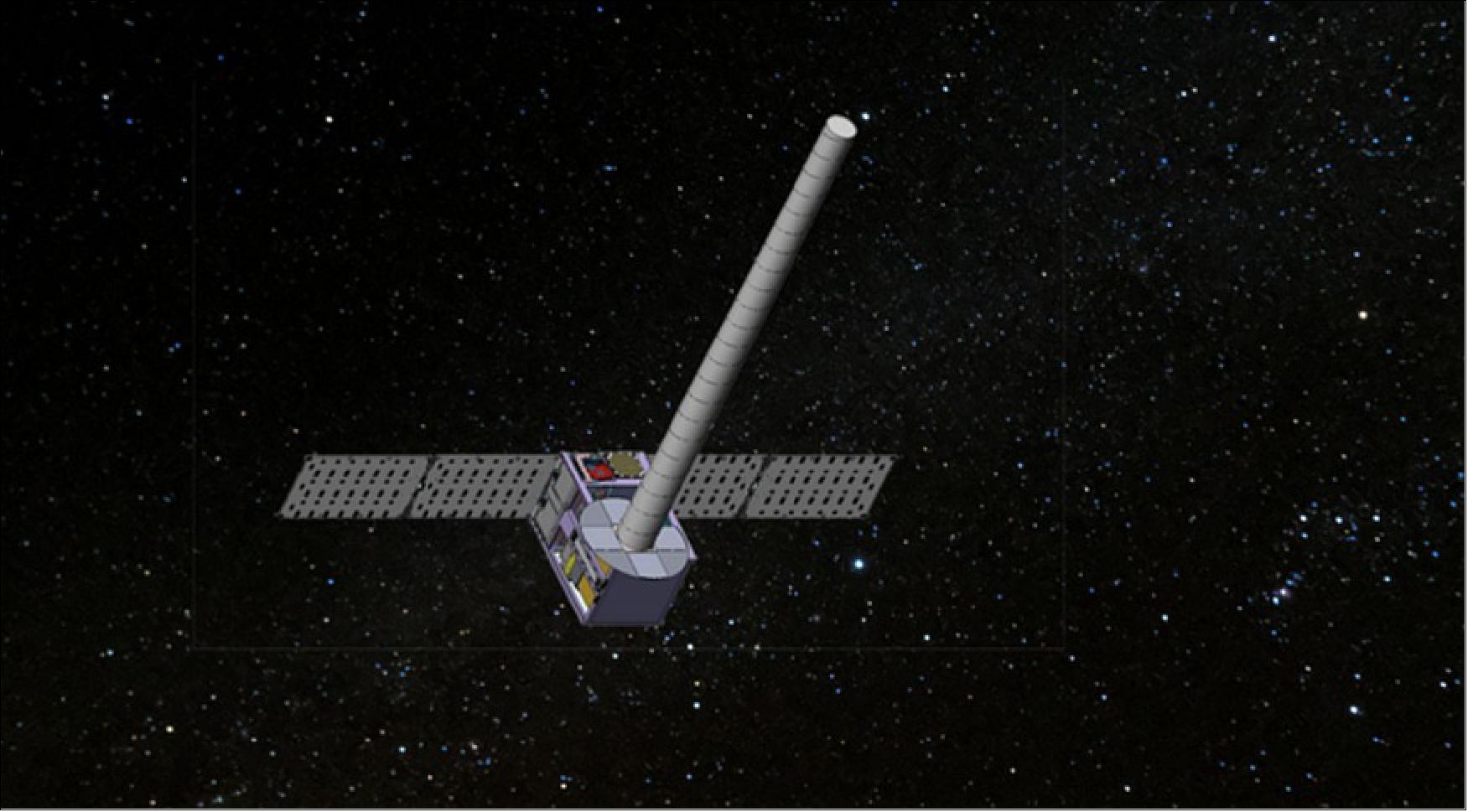
- The Jacksonville, Florida-based space infrastructure company said it’s under contract to deliver 42 high-gain antennas over the next 18 months for an undisclosed national security customer.
- The antennas will be integrated with Viasat’s Link 16 communications terminals. The Link 16 tactical data network is used by the U.S. military and NATO allies to exchange data between ships, aircraft and troops on land.
- A Redwire spokesman said the company could not disclose the value of the contract or the specific customer, and could only say it’s a Defense Department prime contractor.
- Based on a previous announcement, the customer is either York Space Systems or Lockheed Martin, both of which are prime contractors building satellites for DoD’s Space Development Agency. The agency plans to deploy a Transport Layer — a low Earth orbit mesh network that will send and receive wideband data to and from ground stations and mobile users.
- Redwire in a January 2022 news release said it was under contract to deliver three L-band Link-16 helical antennas for the Space Development Agency’s Transport Layer Tranche 0. That earlier contract was with one of two satellite manufacturers — York Space and Lockheed Martin — that received contracts in August 2020 to build 10 Transport Layer satellites. Redwire did not specify which of the two satellite suppliers was the customer for the three antennas.
- York Space Systems, Lockheed Martin and Northrop Grumman in February won contracts from SDA to each produce 42 satellites for the Transport Layer Tranche 1.
- The Link 16 antennas are important pieces of the Transport Layer satellites that have to be able to transmit and exchange data with all users of the Link 16 tactical data standard.
- Redwire will produce high-gain antennas, a type of antenna with a narrow radio beam that is used to amplify weak satellite signals.
- The company said the antennas will be manufactured at its Longmont, Colorado, facility.
- The Link 16 antennas are designed and built by Deployable Solutions, formerly known as Roccor, a company acquired by Redwire.
- Under a 2017 Small Business Innovation Research contract with the Air Force Research Laboratory Space Vehicles Directorate, Roccor developed a deployable L-band antenna that can receive and transmit Link 16 signals via satellite. The carbon-fiber antenna boom has been successfully deployed on commercial satellites.
• May 26, 2022: General Dynamics Mission Systems won a $324.5 million contract to operate the ground systems and manage network operations of the Space Development Agency’s low Earth orbit constellation, the agency announced May 26. 9)
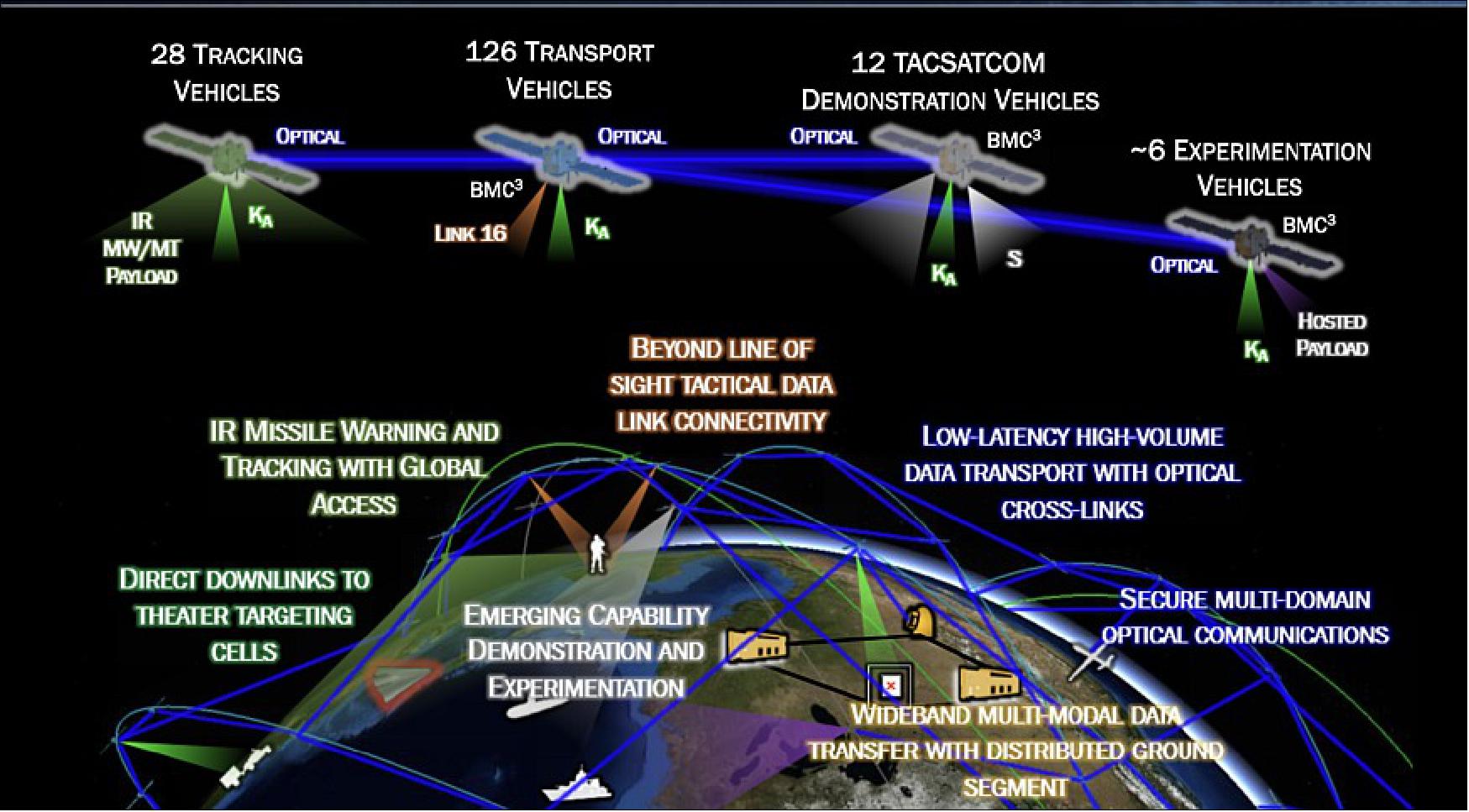
- The seven-year contract is for $162.9 million as a baseline, with $161.5 million in options to establish the ground operations and integration (O&I) segment for SDA’s Tranche 1 constellation, a mesh network projected to have as many as 166 communications, data-relay and sensor satellites to support military users around the world.
- The base contract runs from May 2022 until January 2025, and options would extend the contract until September 2029.
- The O&I contract is “cost plus,” a type of contract used by the Pentagon for the development of new technologies where the contractor is paid based on the cost of the project plus an additional fee.
- SDA procures its satellites under fixed-price contracts but decided the O&I agreement with General Dynamics should be cost-plus, an SDA official told reporters. There is a risk that, because of its complexity, the cost of the project could exceed the original estimates and the government should absorb “a certain amount of risk” the official said.
- General Dynamics for this bid teamed with Iridium Communications. Other partners include KSAT, Emergent and Raytheon.
- The scope of the contract is broad, including network management and constellation monitoring across ground space, and user segments.
- The O&I contractor will stand up two operations centers located at government facilities in Grand Forks Air Force Base, North Dakota, and Redstone Arsenal in Huntsville, Alabama. Additionally it will have to develop 14 new ground stations, or data entry points: eight Ka-band, two S-band and four with optical communications.
- Three satellite manufacturers selected so far for the Transport Layer Tranche 1 — Lockheed Martin, Northrop Grumman and York Space Systems — will operate their spacecraft using their own ground stations but the O&I contractor will coordinate data traffic and manage the command and control of the mission payloads such as the inter-satellite crosslinks and the on-orbit data processors. Transport Layer Tranche 1 satellites are projected to launch in 2024.
- Two more satellite suppliers are expected to be selected for Tranche 1 of the Tracking Layer of missile-detecting satellites, which would launch in 2025.
- The O&I contractor will have to figure out a common ground architecture to integrate satellites from all seven vendors. This is a complex task, the SDA official said, and “carries the highest risk.” The success of Tranche 1, said the official, depends on successful integration of the satellites, ground systems and user equipment.
- SDA received seven proposals for the O&I contract, the official said.
- Collin Lee, director of Frontiers – a space technology incubator for General Dynamics Mission Systems — said in a statement to SpaceNews that the company’s team brings a “long heritage of mission-critical space and ground communications and networking expertise to the Space Development Agency.”
- “Iridium, General Dynamics Mission Systems and the U.S. government have a long and successful history of working together and partnering on this project is a natural evolution of our relationship,” said Matt Desch, CEO of Iridium. “Iridium’s 25 years of experience operating in LEO makes us uniquely qualified for this opportunity.”
• May 17, 2022: Facing a tight schedule to launch 28 satellites between September 2022 and March 2023, the Space Development Agency (SDA) and its contractors have had to scramble to deal with parts shortages and other supply chain problems that have affected the entire space industry. 10)
- Some satellite programs have been impacted by delays in the deliveries of microprocessors and focal planes arrays but SDA mostly has had to contend with a shortage of lower-end items, the agency’s director Derek Tournear said May 17.
- “What caught us off guard were some of the lower level components that you didn’t expect to have problems with — resistors, cables, connectors, things that you would expect are always a little difficult but usually you can control,” Tournear said at a Potomac Officers Club online event.
- Tournear credited SDA’s satellite manufacturers for having “a pretty good handle from the beginning. They knew from day one that the supply chain would be a risk factor for those space qualified parts.”
- Lockheed Martin and York Space Systems are each producing 10 communications satellites for SDA’s Transport Layer Tranche 0. L3Harris Technologies and SpaceX are each making four infrared sensor satellites for the Tracking Layer Tranche 0.
- SDA plans to launch its first 14 satellites in September. “Basically we have zero days of margin for that launch,” Tournear said.
- An item of concern right now are Ka-band radios needed for the satellites, Tournear said. “Our risk items are our Ka radios. We’re having a difficult time getting our radios built and delivered in time. And that’s because of the internal components that are going into those.”
- Optical crosslink terminals used to pass data from satellite to satellite also are experiencing production delays, he said.
- “We’ve had to shift around different vendors.” Lockheed Martin and York Space even agreed to share parts, Tournear said. “Our Transport Layer performers have been extremely helpful in sharing parts between one another.”
- “One vendor had radios ahead of schedule that they didn’t need until the second launch. The other vendor had optical crosslinks come in ahead of schedule, but they didn’t need them until the second launch,” he said. “And they were willing to actually share those with each other so that we hit our launch on time.”
- Tournear said that “sort of competitive camaraderie is kind of rare, but they’ve been able to do that. And that’s helped.”
- Additionally, SDA has reached out to other government agencies to borrow components, he said. “And that’s how we’re able to continue towards this Tranche 0 timeline.”
- Looking ahead to the much larger Transport Layer Tranche 1 – with Lockheed Martin, York Space and Northrop Grumman each under contract to produce 42 satellites, “we anticipate the same difficulties,” said Tournear.
- On the plus side, “suppliers know what’s coming” so they are likely to be better prepared, he said. “Now the supply chain is geared up and moving forward. So we anticipate that our primes have supply chain plans in place to be able to get the parts on hand and be able to deliver,” he added. “It’s one of those things we have to play whack-a-mole as we build these satellites out.”
• April 23, 2022: The companies are teaming up to compete for an SDA contract to operate the Transport Layer Tranche 1 constellation. Communications satellite operator Iridium and General Dynamics Mission Systems submitted a joint bid to operate and manage the Space Development Agency’s low Earth orbit constellation. 11)
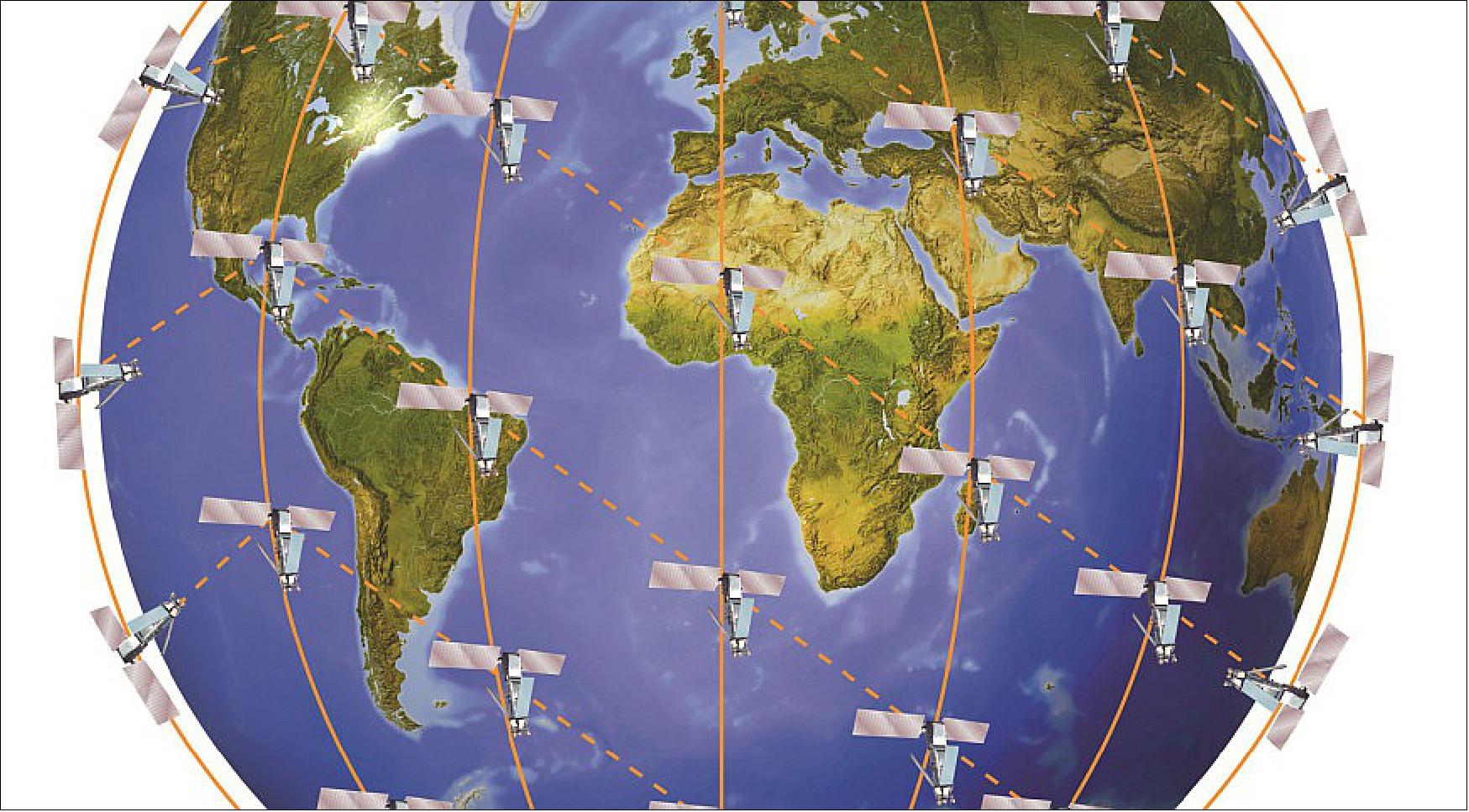
- A spokesman for Iridium confirmed the two companies teamed up on a proposal in response to an SDA request earlier this year. The agency in January issued a request for proposals for the “ground operations and integration segment” for a $1.8 billion constellation known as Transport Layer Tranche 1.
- Iridium’s CEO Matt Desch during an earnings call April 19 told analysts that the company was pursuing the SDA contract but did not discuss the teaming arrangement.
- SDA has ordered 126 satellites from Lockheed Martin, Northrop Grumman and York Space Systems. Each company is responsible for providing 42 satellites and operating them but SDA will select a separate contractor to manage the entire enterprise including the ground stations, data links and user equipment.
- “Iridium and General Dynamics Mission Systems have partnered and submitted an innovative proposal in response to SDA’s RFP for development of their proliferated LEO constellation’s system integration, ground systems, facilities, ground stations and management of day-to-day operations of their network,” Iridium said in a statement to SpaceNews.
- The company operates a constellation of 75 communications satellites in low Earth orbit and provides satcom services to the U.S. government and commercial customers. General Dynamics Mission Systems develops and integrates satcom antennas and ground systems.
- SDA’s technical director Frank Turner described the ground systems integration of Tranche 1 as a complex challenge. “What we need is a team of folks who can take a look at the missions, at what we need to operate from a ground perspective and how to build the constellation, mission and network management to make it all work together,” he said last month at an industry conference.
- The Transport Layer, a mesh network intended to move data in space via optical links, will have two operations centers at government facilities in Grand Forks Air Force Base, North Dakota; and Redstone Arsenal in Huntsville, Alabama. It will have multiple ground entry points, external locations, and terrestrial backhaul communications.
- “The ability of this contractor to work with and manage inputs and actions from multiple other performers will be critical to successfully field and operate Tranche 1,” SDA said. The agency is reviewing bids and expects to select a contractor in the coming months.
• April 10, 2022: The U.S. Space Force is requesting an additional $200 million in fiscal year 2023 to launch two satellites for the Space Development Agency’s missile-tracking constellation. 12)

- The funding for additional launches was included in a $600 million “unfunded requirements” list the Space Force submitted to Congress April 6. The other $400 million is for weapons systems upgrades and classified technologies. These requests would be added to the budget proposal the Biden administration released March 28.
- Derek Tournear, director of the Space Development Agency (SDA), said two more launches need to be funded in 2023 to accelerate the deployment of a $2.5 billion missile-tracking constellation that the agency initially planned to start launching in 2026 but is now looking to accelerate to 2025.
- SDA’s Tracking Layer, a constellation of infrared sensing satellites in low Earth orbit, has emerged as a top priority for the Pentagon amid concerns that current defense systems might not be able to detect high-speed maneuvering missiles. The Tracking Layer is envisioned as a global network of eyes in the sky that would provide a defensive shield against ballistic and hypersonic missiles.
- As many as 100 satellites are planned to be added to the Tracking Layer over the next five years.
- The program is getting a large influx of funding. The Pentagon in 2022 did not request funds for the Tracking Layer but Congress inserted $550 million to speed up the project. The Defense Department’s budget request for fiscal year 2023 includes $500 million for the Tracking Layer.
- The first eight satellites – made by L3Harris and SpaceX – are projected to launch in 2023. The next batch of at least 28 satellites would launch in 2025.
- After Congress passed the 2022 budget in March, SDA issued a request for industry bids for at least 28 satellites – Tracking Layer Tranche 1 – and proposals are due April 20.
- At a news conference April 5 at the Space Symposium, Tournear said he expects the agency to award contracts in June so satellites can be ready for launch in 2025. Two vendors are likely to be selected to provide 14 or more satellites each. Tournear said he anticipates six to 10 bids for this contract.
- The agency’s strategy, known as “spiral development,” is to buy satellites every two years so it can tap into the latest technologies and bring new vendors into the program. The next batch of satellites, Transport Layer Tranche 2, could have as many as 50.
- SDA also is developing a global network of broadband satellites in low Earth Orbit known as the Transport Layer. The data collected by Tracking Layer satellites would be sent via optical links to the Transport Layer so if a missile threat is detected, its location and trajectory data can be transmitted securely through space and downlinked to military command centers.
- “I think that proliferated low Earth orbit with spiral development is now accepted as an activity that will provide us the capabilities we need in the future,” Tournear said. “And if you look at the plus-ups that we received from Congress in 2022, that is an endorsement of our ability to be able to deliver on the capabilities that have been promised.”
- The Pentagon’s proposed 2023 budget includes $314 million for three launches for the Transport Layer. Tournear said the budget submitted March 28 did not include any Tracking Layer launches because that proposal was put together before Congress added $550 million for tracking satellites.
- The congressional add-on meant SDA had to move up the procurement of the satellites and the launches, Tournear said.“When the president’s budget request for 2023 was submitted from the department, we didn’t anticipate launching as early as 2025. So we’re working with the appropriators to correct any mismatch.”
- Because of the lead time required by the Space Force’s national security space launch program, launches are funded two years before the actual launch.
• March 23, 2022: Frank Turner, technical director of the Space Development Agency (SDA), said companies that manufacture their own satellites buses are bidding much lower prices than those that don't. 13)
- Of the three companies selected by the Space Development Agency to produce 126 satellites, only one, York Space Systems, manufactures satellites in-house.
- That likely explains why York Space’s bid for 42 satellites was nearly half the price of what the other two winners bid for the same number of satellites, Frank Turner, technical director of the Space Development Agency (SDA), said March 21 at the Satellite 2022 conference.

- SDA last month awarded three contracts: $700 million to Lockheed Martin, $692 million to Northrop Grumman and $382 million to York Space for the Transport Layer Tranche 1. Each company has to deliver 42 satellites by 2024.
- The Transport Layer will be the Defense Department’s first-ever internet in space — a network of small satellites in low Earth orbit to support military communications, surveillance and tracking of enemy targets.
- Turner pushed back on suggestions that SDA did not reward bidders for competitive pricing. “Did we pick the most expensive? Actually we didn’t,” he said, noting that the three companies selected ranked first, third and fourth on pricing from a total of eight bids.
- “I want to be very clear that when we put the requirements out for companies to bid against, the requirements are set, and we asked for the best possible firm fixed price bid, and that’s what everybody sent us,” said Turner.
- It’s obvious that one of them was much lower than the others, he added. What likely explains that is that York Space internally manufactures its satellites whereas Lockheed Martin and Northrop Grumman are buying the satellite buses from partner companies. “That is something that we’re seeing on both of our first two tranches, that one company is much lower than the other,” he said.
- “When you see the three awards that we made, two to very large traditional defense primes that are not building their own satellites, they’re actually buying them,” Turner said. “Only one of our primes is literally building their own buses. And I think we’re seeing that in some of the costs that we’re getting.”
- The winners were selected based on their ability to “meet the requirements with a commoditized bus on the schedule that we need, at a reasonable fixed price,” he said.
- Turner said SDA is trying to create a competitive marketplace with real opportunities for companies to win satellite contracts every two years. The agency has said it wants to avoid “vendor lock,” or becoming dependent on a single vendor for any product or service.
- However, two of the winners of Transport Layer Tranche 1 — Lockheed Martin and York Space — also won Transport Layer Tranche 0 in 2020.
- That seems to contradict SDA’s rhetoric, Turner said. The agency is aware of that and is trying to figure out ways to open up the playing field despite government contracting rules that often favor incumbents because they have more experience.
- “That’s actually something that has bothered me a little bit since we did the acquisition for the latest round of satellites,” he said. “We firmly believe at SDA that we do not have incumbents. We firmly believe that what we’re trying to do is create a marketplace and send a demand signal to the market.”
- “The problem is we’re struggling a little bit to actually put our money where our mouth is, so to speak,” he said. “Two of our Tranche 0 incumbents got a Tranche 1 contract, not because we believe in incumbents but because they wrote the best proposals and as the government, that’s what we get to pick.”
- SDA also is concerned about lower-tier suppliers, said Turner.
- “The government is still struggling with how to do this,” Turner added. SDA, a three-year-old agency, is trying to come up with a new business model and is learning on the go.
• February 28, 2022: The Space Development Agency (SDA) today announced the awards of three prototype agreements worth approximately $1.8 billion to establish the foundation for Tranche 1 Transport Layer (T1TL), a mesh network of 126 optically-interconnected space vehicles (SV) that will provide a resilient, low-latency, high-volume data transport communication system, and be ready for launch starting in September 2024. 14)
- These agreements are awarded to York Space Systems, Lockheed Martin Space, and Northrop Grumman Space Systems to each build and demonstrate effectiveness for two near-polar low Earth orbital planes of the six-plane T1TL, which forms the initial warfighting capability tranche of the National Defense Space Architecture (NDSA).
- “These awards will drive delivery of the NDSA’s data and communications Transport Layer through a proliferated constellation of relatively small, mass-producible space vehicles in low Earth orbit,” said Derek Tournear, SDA director. “Through our solicitations, we aim to create a marketplace through two-year spiral development and regular, full and open solicitations for each tranche so that industry can plan, develop and grow accordingly. We look forward to collaborating with our industry partners to deliver the capabilities the warfighter needs through Tranche 1 and beyond.”
- Tranche 1 Transport Layer will leverage and proliferate the capabilities being demonstrated in Tranche 0 Transport Layer with targeted technology enhancements, mission-focused payload configurations, increased integration, and greater production efficiencies. The T1TL will provide global communications access and deliver persistent regional encrypted connectivity in support of warfighter missions around the globe by serving as the backbone for Joint All Domain Command and Control (JADC2) built on low-latency data transport, sensor-to-shooter connectivity, and direct-to-weapon platforms connectivity.
- York Space Systems, Denver, is awarded a prototype agreement with a potential value of approximately $382 million to execute a research and development program for the development of a T1TL prototype constellation consisting of 42 satellites in two near-polar low Earth orbital planes (21 SVs for each orbital plane). The proposal was received and evaluated under an Other Transaction Authorities solicitation SDA-PS-22-01. “We are honored to again have SDA’s confidence in executing the agency’s vision,” said Dirk Wallinger, chief executive officer, York Space Systems. “Their competitive, fixed-price procurements leverage York's private capital investments to deliver low-risk, industry-leading constellations today and well into the future." The Space Development Agency is the contracting activity (HQ08502290003).
- Lockheed Martin Corporation, Littleton, Colo., is awarded a prototype agreement with a potential value of approximately $700 million to execute a research and development program for the development of aT1TL prototype constellation consisting of 42 satellites in two near-polar low Earth orbital planes (21 SVs for each orbital plane). The proposal was received and evaluated under an Other Transaction Authorities solicitation SDA-PS-22-01. “Our team at Lockheed Martin is thrilled to be awarded a T1TL contract,” said Erik Daehler, Protected Communications Mission Area leader at Lockheed Martin Space. “We’re looking forward to building upon our team’s success on Tranche 0 by approaching Tranche 1 with modernized and streamlined processes that do more, cost less and achieve mission goals faster. Producing these innovative spacecraft will be a collaborative effort, with Lockheed Martin using its longstanding partnerships to deliver high-quality products that will provide the right capabilities to the warfighter.” The Space Development Agency is the contracting activity (HQ08502290001).
- Northrop Grumman Strategic Space Systems, Redondo Beach, Calif., is awarded a prototype agreement with potential value of approximately $692 million to execute a research and development program for the development of a T1TL prototype constellation consisting of 42 satellites in two near-polar low Earth orbital planes (21 SVs for each orbital plane). The proposal was received and evaluated under an Other Transaction Authorities solicitation SDA-PS-22-01. “Northrop Grumman recognizes information on the modern battlefield must be delivered to our warfighters at the speed of relevance,” said Robert Fleming, vice president and general manager, Strategic Space Systems. “Our T1TL solution combines proven end-to-end satellite system integration and heritage communication mission expertise accumulated over decades, across multiple orbital regimes to rapidly field these critical capabilities to warfighters in the field.” The Space Development Agency is the contracting activity (HQ08502290002).
- About the Space Development Agency. Recognized as DOD’s constructive disruptor for space acquisition, SDA will accelerate delivery of needed space-based capabilities to the joint warfighter to support terrestrial missions through development, fielding, and operation of the National Defense Space Architecture.
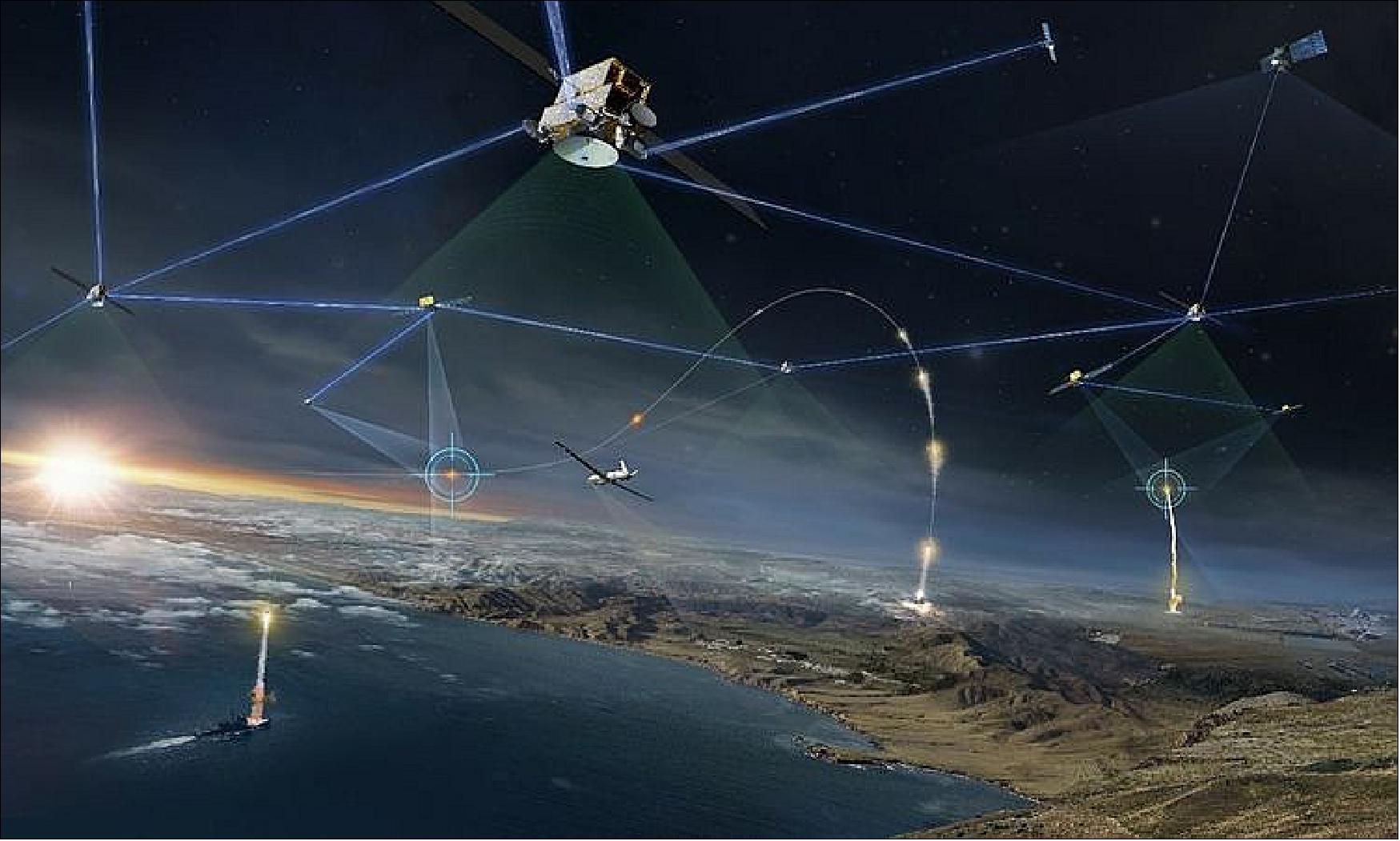
• February 10, 2022: The Defense Department’s Space Development Agency is looking for ways to rapidly acquire Earth observation data, Frank Turner, SDA technical director, said at the SmallSat Symposium in Mountain View, California. 15)
- “We’ve talked to a number of commercial providers in this conference and elsewhere about how we can connect to your systems and enable the operators to use your data for tactical missions,” Turner said during a Feb. 10 keynote address. “We want to understand how that works and how we can make it beneficial for both ourselves as the government and you as commercial providers.”
- Synthetic radar satellite constellation operator Capella Space is one of SDA’s first commercial data partners.
- Hybrid architecture is a popular term for government and commercial satellites working in partnership.
- “I want to drive that concept all the way down from the hardware layer to the information layer,” Turner said. “As you are developing commercial information, how can I get access to that information and provide it to the warfighter and make it usable?”
- To date, SDA has focused primarily on acquiring satellites more quickly, in greater quantity and at lower prices than the Defense Department has traditionally paid.
- Lockheed Martin and York Space Systems won SDA contracts in 2020 to produce 10 satellites apiece for SDA’s Transport Layer Tranche 0. Fourteen of the 20 satellites, scheduled to begin launching in September, will be equipped with four optical intersatellite links. The other six will have two optical intersatellite links, plus Link 16 tactical data network payloads.
- The average cost of the satellites will be $14.1 million, Turner said.
- For SDA Transport Layer Tranche 1, the average cost of the 126 satellites is likely to fall in the $9 million to $11 million range, Turner said. Each satellite is expected to feature four optical intersatellite links, a Link 16 payload and Ka-band communications for transmitting and receiving mission-related data.
- SDA also intends to buy 28 missile-tracking satellites for the Tracking Layer Tranche 1. That program will not begin this year as expected, though, unless Congress provides funding.
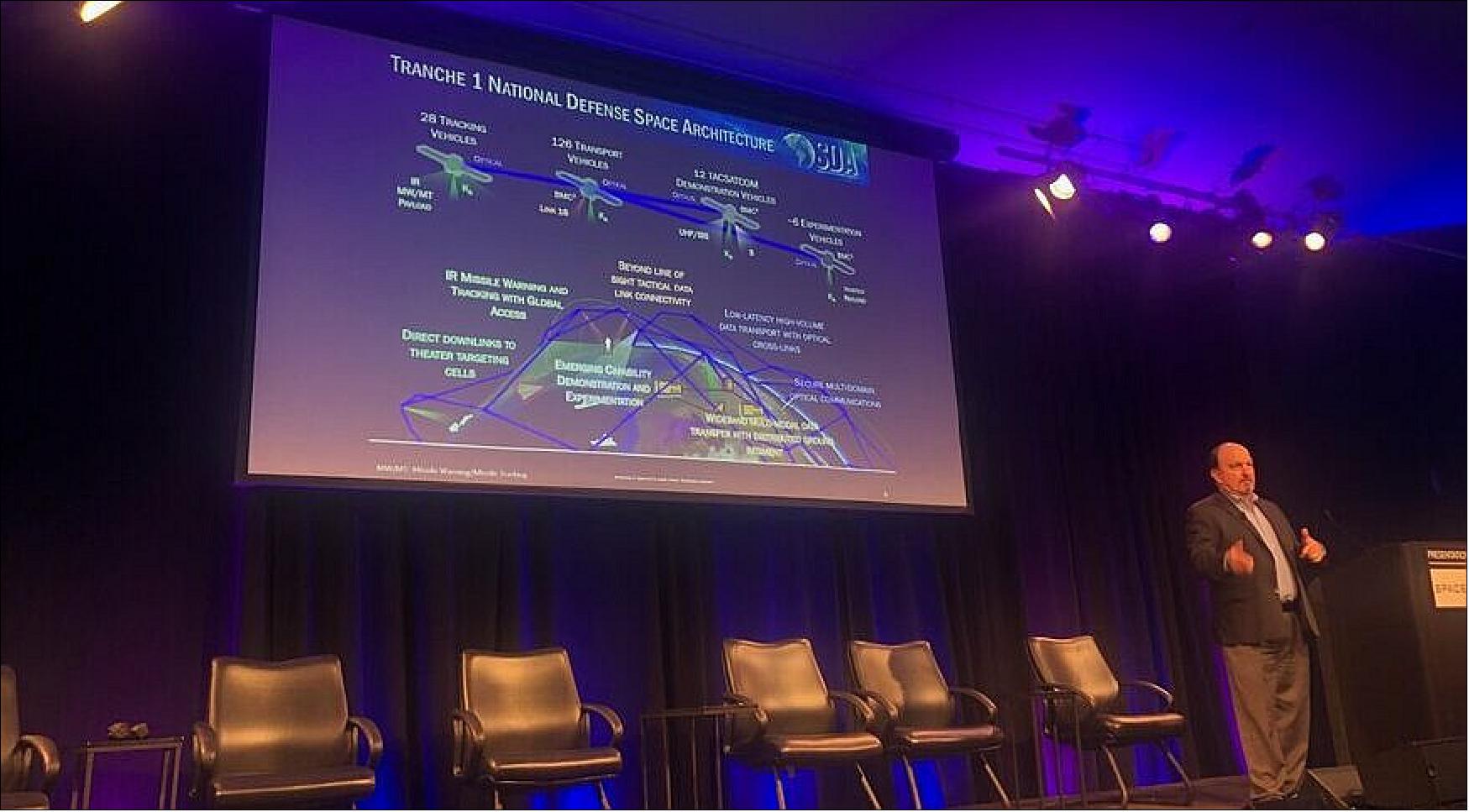
- “If we get a budget this year, we think we’re going to get money for tracking,” Turner said. “If we don’t get a budget or if the budget doesn’t look the way we think it may well look, then that will fall off the table.”
- SDA plans to announce contracts for Transport Layer Tranche 1 by the end of the month, Turner said.
- In parallel, SDA is soliciting proposals for the ground architecture to support Transport Layer Tranche 1.
- “It’s a heck of a problem and I apologize for that,” Turner said. “We need a team of folks who can take a look at the missions, at what we need to operate from a ground perspective, and how to build the constellation management, mission management and network management to make it all work together.”
- Speed is SDA’s primary objective as the agency races to adopt advanced technology and establish a proliferated constellation of satellites in low Earth orbit. To speed the flow of information to military forces around the world, SDA wants to avoid sending data to the ground for processing and back to space for distribution to people around the world.
- “We’re extremely interested in the kinds of algorithms we can put on orbit, the kinds of compute capabilities we can put on orbit,” Turner said.
About the Space Development Agency (SDA)
Recognized as DOD’s constructive disruptor for space acquisition, SDA will accelerate delivery of needed space-based capabilities to the joint warfighter to support terrestrial missions through development, fielding, and operation of the National Defense Space Architecture.
• November 17, 2021: Under a recent deal signed with the U.S. Space Development Agency, Capella Space will attempt to connect one of the company’s imaging satellites to SDA’s network of satellites in low Earth orbit. 16)
- Establishing data pipes in space for commercial imagery providers to pass data to government customers could be a win-win, SDA Director Derek Tournear said Nov. 16 at a Center for Strategic and International Studies event.
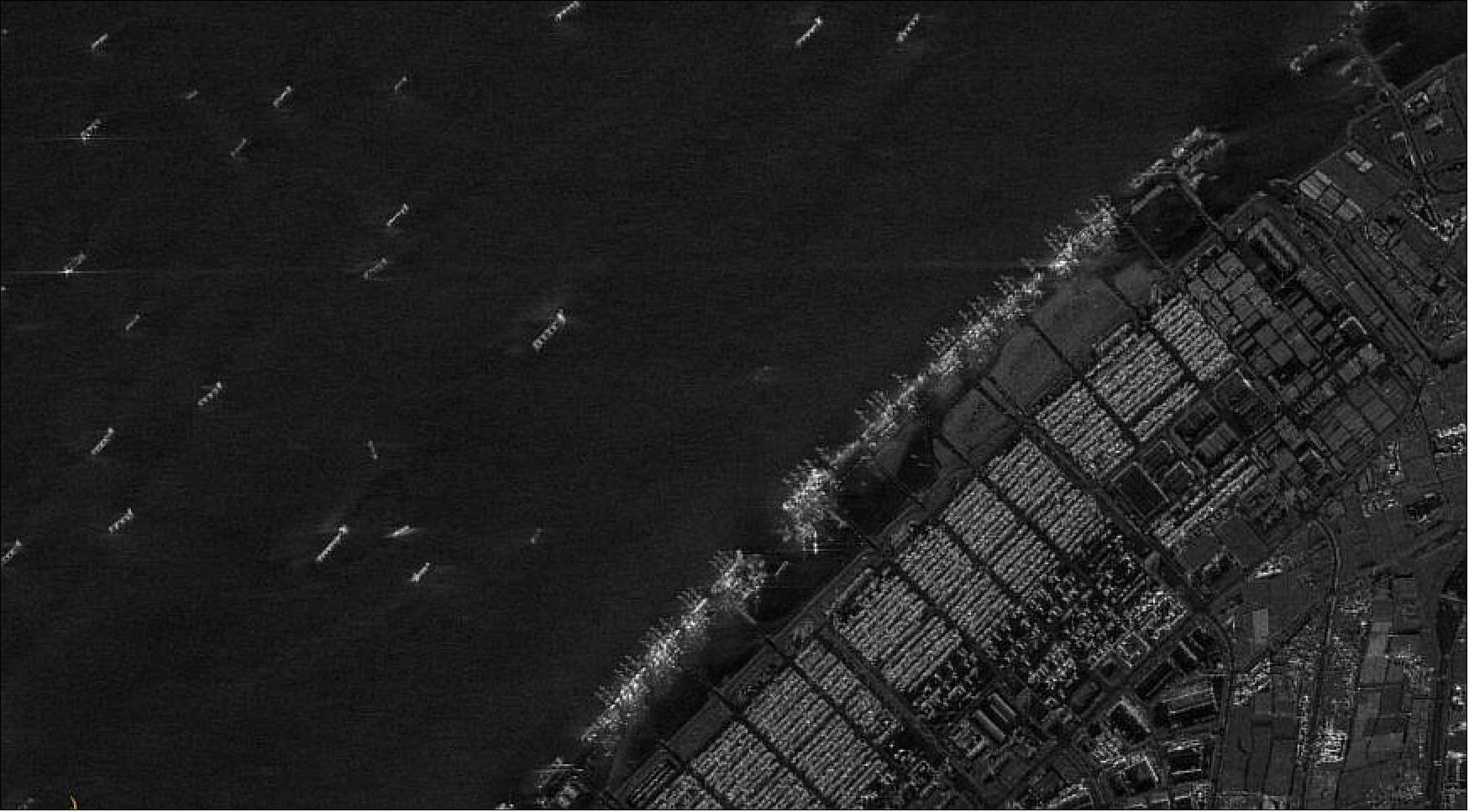
- This would benefit military users who want to tap into the commercial Earth observation imagery marketplace, said Tournear, For the industry, “it gives them a completely new path to market.”
- Capella’s and SDA’s satellites will be connected via a Mynaric laser communications terminal. “We’re working with them so that they can plug in directly into our transport layer,” said Tournear.
- The imagery provided by Capella is from synthetic aperture radar (SAR) satellites. Tournear said SDA would like to sign similar deals with other suppliers of various types of imagery. “We would love to do that with all commercial providers,” he said. “Obviously there’s a lot of security constraints there, and we have to figure out the right way to make that handshake and make that work.”
- To do business with SDA, imagery providers will have to install SDA-approved optical inter-satellite links on their satellites. The data would be passed to SDA’s Transport Layer, a mesh network of communications satellites in low Earth orbit projected to start launching in 2022.
- This gives industry the option of sending data “directly into the Transport Layer, directly to the user, it’s another offering that they can use to sell their data,” Tournear said. Military customers “would pay that commercial company either by the data stream or have some kind of subscription service.”
• November 9, 2021: Capella Space will begin installing optical communications terminals on synthetic-aperture radar (SAR) satellites in 2022 as part of a campaign to quickly deliver data to DoD customers via the Space Development Agency’s low Earth orbit constellation, the company announced Nov. 9. 17)

- “Our team at Capella Space is thrilled to become the first commercial SAR company to demonstrate compatibility with the SDA’s National Defense Space Architecture and standards,” Christian Lenz, Capella Space chief technology officer, said in a statement. “Enabling our satellites to integrate with the new SDA architecture efficiently is a critical step for us to work seamlessly with the U.S. defense and intelligence sector. We are proud to be able to work with the SDA in demonstrating this cutting-edge technology.”
- Capella selected Mynaric’s CONDOR Mk3 optical communications terminal to transmit data from its own satellites in low Earth orbit to government satellites and to military ground stations.
- SDA plans to start deploying a mesh network of satellites known as Transport Layer in late 2022. The agency is interested in working with operators of electro-optical, radar imaging or other types of observation satellites that have optical crosslink on their satellites so they can talk directly to the Transport Layer. SDA said the goal is to make it easier for satellite operators to sell their data to the government without having to download it to ground stations.
- “We are honored to be selected as the optical communications terminal vendor for Capella Space’s integration work with the SDA,” Mynaric CEO Bulent Altan said in a statement. “Our recently announced CONDOR Mk3 is fully compliant to the SDA’s interoperability standard and a natural match for Capella’s innovative approach integrating commercial capabilities with governmental customers.”
- When Mynaric unveiled CONDOR Mk3 in August at the Space Symposium in Colorado Springs, the company said an undisclosed customer, who had secured options for as many as 20 units, was scheduled to begin receiving deliveries in the fourth quarter of 2022. Mynaric now confirms the customer it was referring to was Capella.
- Mynaric will deliver one terminal in 2022 to Capella for an in-space interoperability demonstration with SDA in early 2023. The company plans to ramp up production of CONDOR terminals to high double digits per month by the end of 2022.
- Capella has established relationships in the last year with U.S. government agencies including the U.S. Army, U.S. Navy, U.S. Air Force, U.S. Space Force, National Geospatial-Intelligence Agency and SDA. In-Q-Tel, the U.S. intelligence community’s nonprofit investment organization, also is supporting Capella.
• June 17, 2021: Radar satellite imagery startup Capella Space on June 14 received a $3 million research contract in support of the Space Development Agency’s National Defense Space Architecture. 18)
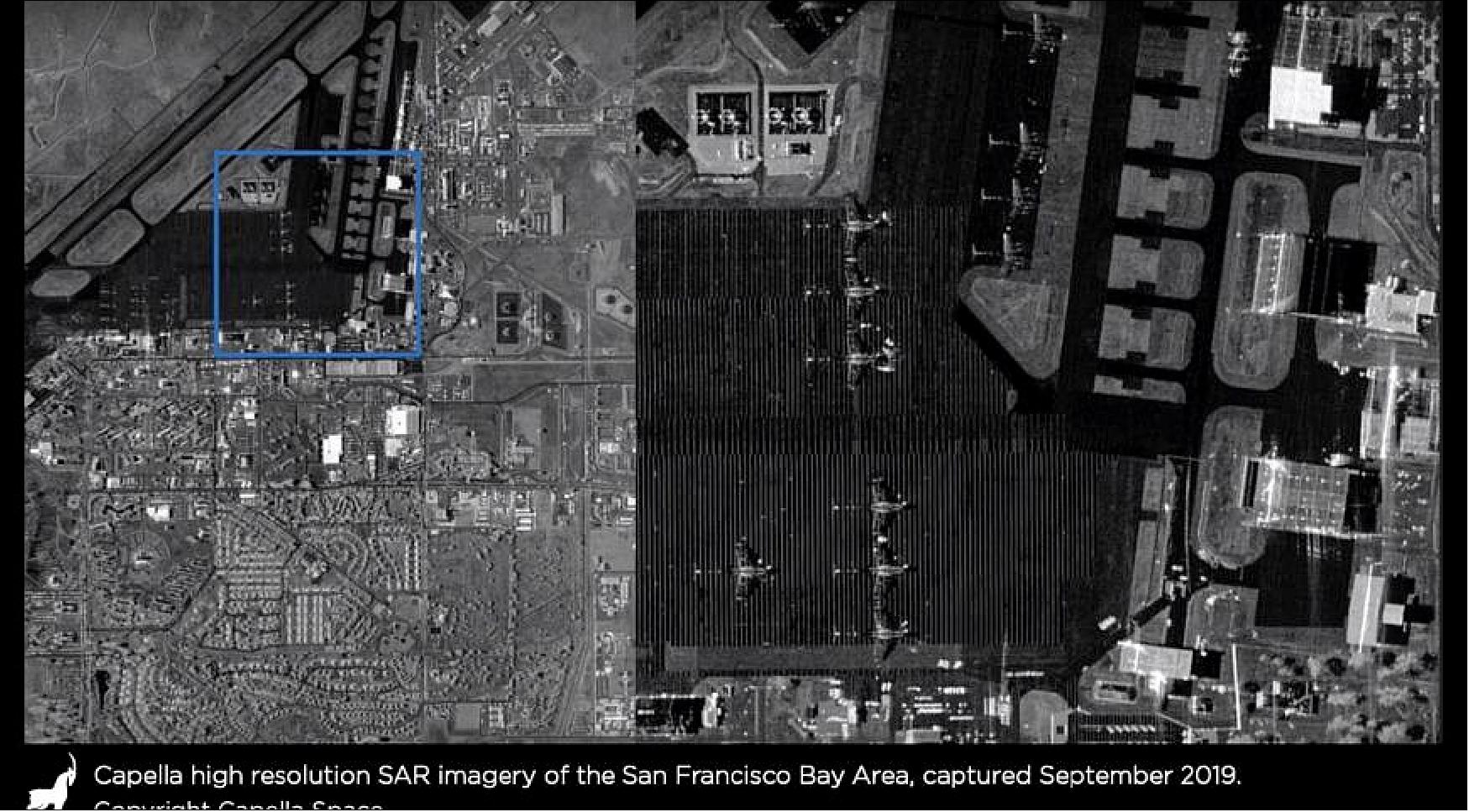
- Capella Space was selected through a “broad agency announcement” issued by the space agency in January seeking proposals on a wide range of technologies for “National Defense Space Architecture Systems, Technologies, and Emerging Capabilities.” The award was posted on the federal contracts website SAM.GOV.
- Based in San Francisco, Capella Space is building a constellation of synthetic aperture radar (SAR) imaging satellites that can see through clouds and darkness.
- “We are delighted for the opportunity to work with the Space Development Agency,” Capella’s founder and CEO Payam Bazanadeh said in a statement to SpaceNews. “As the first and only American SAR company, this further expands our existing partnership with the U.S. government.”
- The SDA is building a network of satellites in low Earth orbit for U.S. military communications and missile defense. It is developing a Transport Layer of data-relay satellites and a Tracking Layer of sensor satellites to detect and track missiles.
- The agency in the broad area announcement (BAA) said it is interested in “novel remote sensing phenomenologies.” The agency is looking for “innovative distributed sensing concepts, novel sensing modalities, with applications to missile threat detection and tracking and surveillance of time critical targets.”
- The BAA asked companies for concepts and assessments of how their technologies could support the SDA’s space architecture.
- Capella Space last year won a DoD contract to provide airborne SAR data to the U.S. Navy. The company also has received contracts from the U.S. Air Force and the National Reconnaissance Office.
References
1) Sandra Erwin, ”DoD space agency to create marketplace for commercial satellite data,” SpaceNews, 23 June 2021, URL: https://spacenews.com/dod-space-agency-to-create-marketplace-for-commercial-satellite-data/
2) Sandra Erwin, ”SpaceX or ULA to launch future Space Development Agency satellites,” SpaceNews, 26 July 2021, URL: https://spacenews.com/spacex-or-ula-to-launch-future-space-development-agency-satellites/
3) ”Transport,” SDA, URL: https://www.sda.mil/transport/
4) Sandra Erwin, ”L3Harris, Northrop Grumman to build 28 missile-tracking satellites for U.S. Space Development Agency,” SpaceNews, 18 July 2022, URL: https://spacenews.com/l3harris-northrop-grumman-to-build-28-missile-tracking-satellites-for-u-s-space-development-agency/
5) Sandra Erwin, ”Northrop Grumman selects Airbus to supply satellite buses for U.S. military constellation,” SpaceNews, 5 July 2022, URL: https://spacenews.com/northrop-grumman-selects-airbus-to-supply-satellite-buses-for-u-s-military-constellation/
6) Sandra Erwin, ”Northrop Grumman demonstrates Mynaric laser terminals for military constellation,” SpaceNews, 14 June 2022, URL: https://spacenews.com/northrop-grumman-demonstrates-mynaric-laser-terminals-for-military-constellation/
7) Sandra Erwin, ”House armed services panel calls on DoD to buy commercial space technology and data,” SpaceNews, 8 June 2022, URL: https://spacenews.com/house-armed-services-panel-calls-on-dod-to-buy-commercial-space-technology-and-data/
8) Sandra Erwin, ”Redwire to produce tactical communications antennas for military satellites,” SpaceNews, 7 June 2022, URL: https://spacenews.com/redwire-to-produce-tactical-communications-antennas-for-military-satellites/
9) Sandra Erwin, ”General Dynamics wins ground systems contract for Space Development Agency’s megaconstellation,” SpaceNews, 26 May 2022, URL: https://spacenews.com/general-dynamics-wins-ground-systems-contract-for-space-development-agencys-megaconstellation/
10) Sandra Erwin, ”Space Development Agency’s satellite contractors team up to deal with supply shortages,” SpaceNews, 17 May 2022, URL: https://spacenews.com/space-development-agencys-satellite-contractors-team-up-to-deal-with-supply-shortages/
11) Sandra Erwin, ”Iridium and General Dynamics submit joint bid for Space Development Agency contract,” SpaceNews, 23 April 2022, URL: https://spacenews.com/iridium-and-general-dynamics-submit-joint-bid-for-space-development-agency-contract/
12) Sandra Erwin, ”Space Development Agency to accelerate deployment of missile-tracking satellites,” SpaceNews, 10 April 2022, URL: https://spacenews.com/space-development-agency-to-accelerate-deployment-of-missile-tracking-satellites/
13) Sandra Erwin, ”Satellite supplier with in-house production bid the lowest price for DoD constellation,” SpaceNews, 23 March 2022, URL: https://spacenews.com/satellite-supplier-with-in-house-production-bid-the-lowest-price-for-dod-constellation/
14) ”Space Development Agency Makes Awards for 126 Satellites to Build Tranche 1 Transport Layer,” DoD News Release, 28 February 2022, URL: https://www.defense.gov/News/Releases/Release/Article/2948229/space-development-agency-makes-awards-for-126-satellites-to-build-tranche-1-tra/
15) Debra Werner, ”SDA seeks commercial Earth-observation data,” SpaceNews, 10 February 2022, URL: https://spacenews.com/sda-seeks-commercial-earth-observation-data/
16) Sandra Erwin, ”Space Development Agency a potential ‘path to market’ for commercial satellite imagery,” SpaceNews, 17 November 2021, URL: https://spacenews.com/space-development-agency-a-potential-path-to-market-for-commercial-satellite-imagery/
17) Debra Werner, ”Capella to install optical terminals on imaging satellites to share data with DoD space agency,” SpaceNews, 9 November 2021, URL: https://spacenews.com/capella-sda-demonstration/
18) Sandra Erwin, ”Capella Space wins research contract from U.S. Space Development Agency,” SpaceNews, 17 June 2021, URL: https://spacenews.com/capella-space-wins-research-contract-from-u-s-space-development-agency/